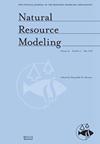KINERS2水文模型用于干旱流域径流模拟的参数分配方法
IF 2.1
4区 环境科学与生态学
Q3 ENVIRONMENTAL SCIENCES
引用次数: 0
摘要
KINERS2模型用于伊朗霍尔莫兹甘省德金流域的径流模拟。使用参数分配程序代替参数优化。在参数分配后,该模型能够充分模拟与高强度峰值流量事件相关的过程线,纳什-萨克利夫的效率值在0.011–0.83之间,克林-古普塔的效率值为0.36–0.98之间,但该模型没有准确模拟与低强度峰值流量事件对应的过程线。尽管参数分配后的校准改善了低强度排放事件模拟的模型性能,但作为最敏感的模型参数的导水率和净毛细管压力的数值与该地区已知的合理参数不一致。因此,导水系数从61降低到55 通道中的mm/h和3.7至1.7 mm/h。新的数值在物理上是合理的,但与德金流域的区域和环境背景相关的物理数值并不大致相同。在这种情况下,Nash–Sutcliffe和Kling–Gupta的评估标准值分别为-2.5和0.78和0.17和0.98。使用R中的HydroPSO软件包对模型进行自动校准的结果表明,在没有智能和深思熟虑地选择参数的情况下进行自动校准无法准确表示水文过程,因此应避免。此外,研究结果表明,作为建模过程的第一步,了解流域环境条件和适当分配参数最初更有效,从而有助于对流域环境条件进行一阶表征。本文章由计算机程序翻译,如有差异,请以英文原文为准。
Parameter allocation approach for runoff simulation in an arid catchment using the KINEROS2 hydrological model
The KINEROS2 model was utilized for runoff simulation in the Dehgin catchment situated in the Hormozgan province of Iran. A parameter allocation procedure was used in lieu of parameter optimization. After parameter allocation, the model was able to adequately simulate hydrographs associated with high‐magnitude peak discharge events with the efficiency values between 0.011–0.83 for Nash–Sutcliffe and 0.36–0.98 for Kling–Gupta, but the model did not accurately simulate hydrographs corresponding to low‐magnitude peak discharge events. Although calibration after parameter allocation improved model performance with respect to the simulation of low‐magnitude discharge events, numerical values of the hydraulic conductivity and net capillary pressure as the most sensitive model parameters did not agree with parameters known to be reasonable in the region. So that the value of hydraulic conductivity was decreased from 61 to 55 mm/h in channels and from 3.7 to 1.7 mm/h in planes. The new values are physically reasonable but are not approximately the same as physical values associated with the regional and environmental context of the Dehgin catchment. In this case, the values of the evaluation criteria were obtained between −2.5 and 0.78 for Nash–Sutcliffe and 0.17 and 0.98 for Kling–Gupta. The results of using the HydroPSO package in R to automated calibration of the model, with the value of Nash–Sutcliffe between −0.63 and 0.43, indicated that autocalibration without intelligent and deliberate selection of parameters cannot accurately represent hydrological processes, and therefore should be avoided. Also, the results show that an understanding of the catchment environmental conditions and appropriate allocation of parameters is initially more effective as a first step of the modeling process and thereby contributes to a first‐order characterization of environmental conditions in the catchment.
求助全文
通过发布文献求助,成功后即可免费获取论文全文。
去求助
来源期刊

Natural Resource Modeling
环境科学-环境科学
CiteScore
3.50
自引率
6.20%
发文量
28
审稿时长
>36 weeks
期刊介绍:
Natural Resource Modeling is an international journal devoted to mathematical modeling of natural resource systems. It reflects the conceptual and methodological core that is common to model building throughout disciplines including such fields as forestry, fisheries, economics and ecology. This core draws upon the analytical and methodological apparatus of mathematics, statistics, and scientific computing.
 求助内容:
求助内容: 应助结果提醒方式:
应助结果提醒方式:


